Reflex actions are involuntary and instantaneous movements in response to stimuli.
A reflex or a reflex action is an instant movement in response to a stimulus.
Some natural pathways called reflex arcs act in an impulse before the impulse reaches the brain, and this makes a reflex or a reflex action.
Have you noticed that sometimes your body reacts to something automatically, even before you think about it?
For example;
What if a ball comes flying at your face?
Your eyelids blink shut quickly and you may even scrunch up your eyes or bring your hands up to your face for extra protection.
These quick movements are called reflexes and they protect your body from harm without you even having to think about it.
Reflexes or reflex actions take place in your body without your brain being involved.
You don’t need to think for a reflex action to happen.
You automatically pull your hand away. This is a withdrawal reflex. This type of a movement happens even before your brain has received information from the sense organs that there is a problem.
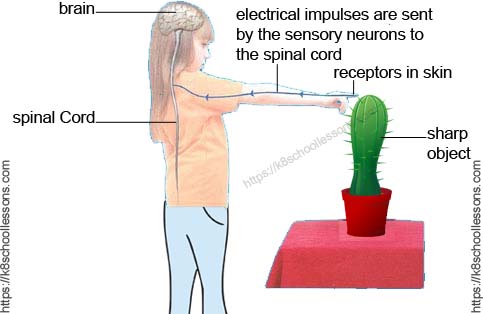 What is your reaction if you touch something hot or sharp?
What is your reaction if you touch something hot or sharp?
Many reflexes are controlled by the spinal cord. Signals travel to the spinal cord along nerves from the receptors of the sense organs. But, even before the information reaches the brain, a signal zaps back out from the spinal cord that tells the effectors, which is the muscles to move. This overall sequence is called the reflex arc.
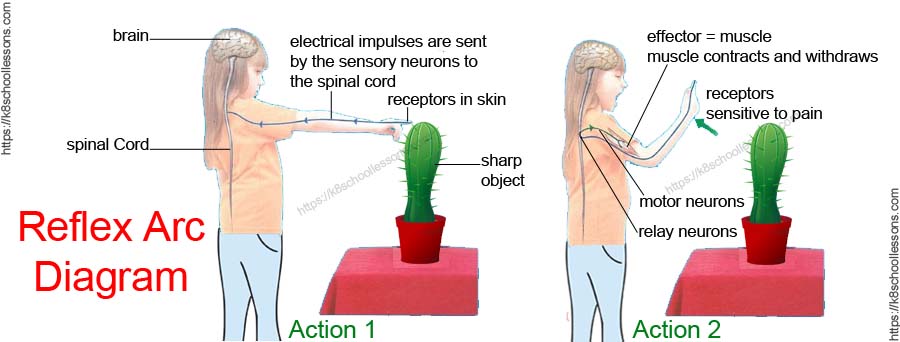 How does a reflex action work – Diagram of Reflex Arc
How does a reflex action work – Diagram of Reflex Arc
Next we are going to learn about the reflex arc in detail. But, before that let’s learn what the spinal cord (Also read Human Nervous System), receptors and effectors are.
The spinal cord is made up of bundles of nerves that connect the brain to other parts of the body. It runs down from the brain through a canal in the center of the bones of the spine (backbone). These bones which surround and protect the spinal cord are called vertebrae.
 Reflex actions through the spinal cord
Reflex actions through the spinal cord
There are specialised groups of cells in each of your sense organ, which are the ear, eye, nose, tongue and the skin. These specialised groups of cells can detect changes or stimuli in the environment. Each organ has receptors sensitive to particular kinds of stimulus.
Location of the receptors | Receptors sensitive to |
Eyes | Light |
Ears | Sound |
Nose | Odour (Chemicals in the air) |
Tongue | Taste (Flavours / Chemicals in your food) |
Skin | Temperature, touch, pressure, pain etc. |
Effectors can be muscles and glands. There job is to produce a specific response to a detected stimulus.
Remember, The signals of a reflex action only travel through relay neurones in the spinal cord. They do not travel through the brain.
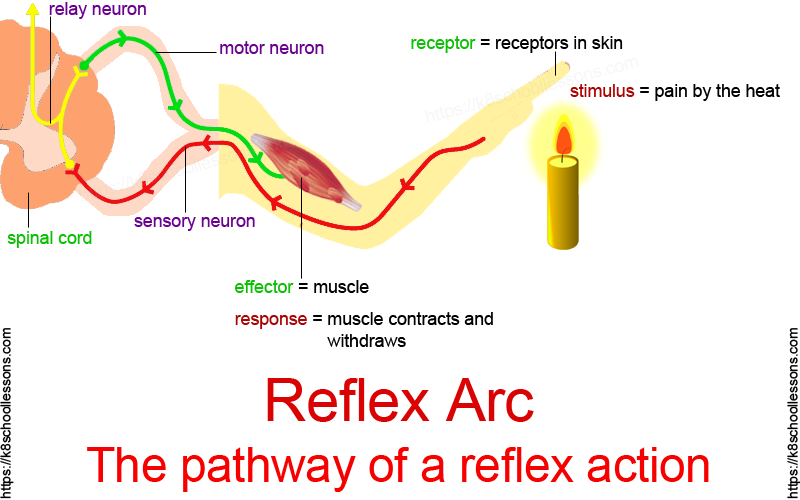 The pathway of a reflex action
The pathway of a reflex action
Sneezing and coughing are also types of reflexes. When harmful substances get into the nose and lungs the body uses them to clear dust and particles out of the airways. This is why it is difficult to control and stop, once you feel that you are about to sneeze.
Reflex action: Sneezing and coughing
Stimulus: Harmful substances get into the nose and lungs
Receptors found in: Nose
Response: Sudden contraction of internal muscles causing a violent exhalation to blow irritant material out.
 Reflex actions examples – Sneezing
Reflex actions examples – Sneezing
Cross your legs and tap just below the knee. Your knee jumps forwards even though your brain hasn’t told it to move.
Reflex action: Knee-jerk
Stimulus: Tapping the knee
Receptors found in: Skin
Response: Due to sudden contraction of front thigh muscles, the lower leg kicks forwards
 Reflex actions examples – Knee Jerk
Reflex actions examples – Knee Jerk
Reflex action: Pupil reflex
Stimulus: Light intensity
Receptors found in: Eye
Response: The diameter of your eye pupil is adjusted by the Iris muscles, wide in dim light, narrow in bright light
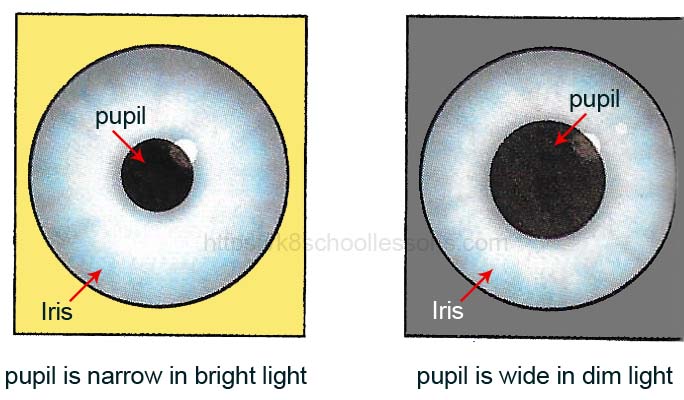 Reflex actions examples – Eye pupil reflex in bright and dim light
Reflex actions examples – Eye pupil reflex in bright and dim light
Reflex action: Sweating
Stimulus: Increased body temperature
Receptors found in: Skin
Response: Increased sweat is released to cool body surface down.
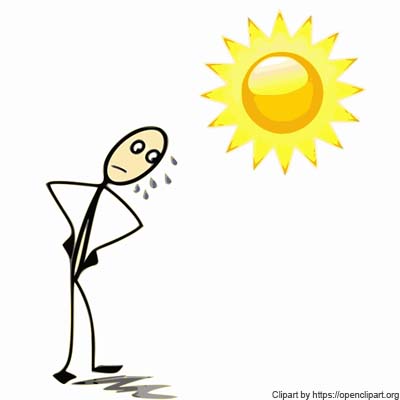 Reflex actions examples – Sweating
Reflex actions examples – Sweating
A baby’s brain is not developed to think and do something. So, babies are born with many reflexes that they need to survive. These are also called instinctive behaviours that are not learned but that they know automatically.
See if you have noticed the following reflexes on your baby sibling?
Rooting reflex – A baby automatically roots around to find its mother’s breast
Suck reflex – A baby starts to suck mother’s milk when its mouth touches mother’s breast
Grasp reflex – It grasps your finger or anything it touches or put in its hand
Startle reflex – When a baby is startled by a loud sound or movement, in response to the change, the baby throws back its head, stretches out its arms and legs, cries, then pulls the arms and legs back in.
Babies also don’t have the control of their bladder. This is why their bladder automatically works and make them urinate when it’s full.
Reflexes in sports
Runners and swimmers need good reflexes as they need to react quickly to the start gun. Tennis players may have less than half a second to react to a ball coming their way.